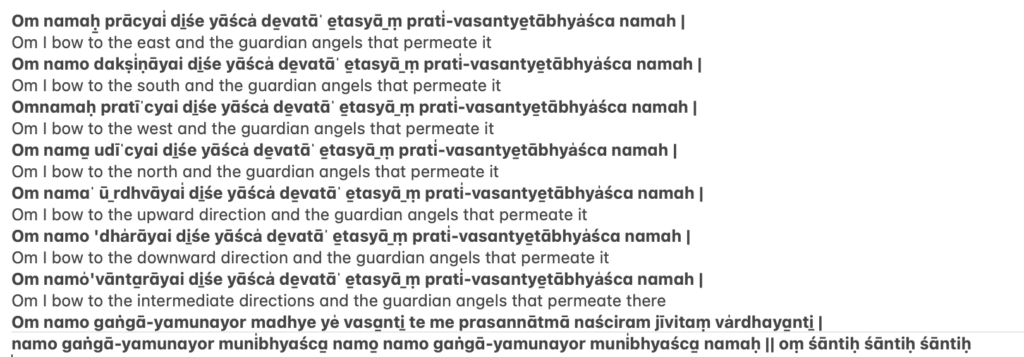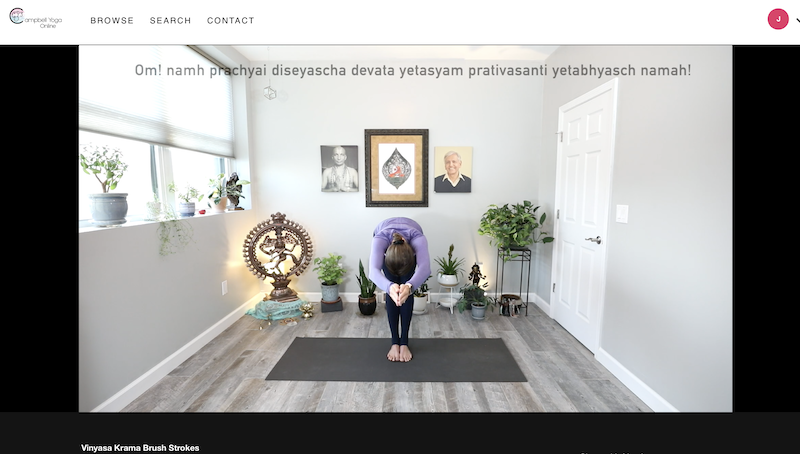Moving Forward: To the Directions
In the vinyasa krama system we have 1000’s of vinyasas at our disposal. Like brushstrokes on a canvas each vinyasa has the potential to reveal something new within the system. In the visesa vinyasas we’ve explored this week several unique vinyasas including surya namaskar, ding namaskar, hanumanasana/anjaneyasana, halasana/paschimottanasana, khagasana and more are available to us. As with all the sequences you’ve likely noticed some that are more easeful to your particular body and some that require a bit more humility. Ramaswami encourages those of us intent in our practice to not glorify one or the other but rather to incorporate both into our sadhana. Both have value when approached with the proper parameters of asana (sthira, sukha, prayatna shaitilya, ananta samapatthi) The point is not the “full expression” but rather to as Patañjali says – to cultivate equanimity amongst the pair of opposites…the middle way.
Looking to the ding namaskar for example. This vinyasa can be approached from the simple perspective of long smooth coordinated breathing. It can involve more or less pause (as the 7:30am crew Thursday experienced) and it can also involve mantra with khumbhaka. Each approach has a unique effect on the system.
Additionally in pranayama there is a progression. Most of you have good control over your breathing in asana (long, smooth, focused on the breath) and that leads to more availability in pranayama to introduce khumbhaka and visama vrtti. If you can go back to the beginning of your practice though you might remember first approaching pranayama by equalizing inhalation and exhalation, then by gradually introducing longer exhales, longer inhales, antah khumbhaka, bahya kumbhaka and even mantra succesively. You slowly introduce different techniques whereby the breath is controlled in different locations in the body. You slowly increase the number of pranayams in any given sitting etc etc. Following patiently through the teachings helps to reveal the full benefit. Staying in the first stage and/or jumping too far ahead to quickly will not yield the same results.
All in all it is beneficial to stay with a particular system. So often, maybe due to the modern yoga studio module, maybe due to capitalism, maybe due to citta vrttis and the mind’s unfettered preference for distraction (time immemorial), it is all too common for students to jump around from one lineage to another. No disparaging here of other teachers or perspectives…just a note on discernment in our approach. The risk here is that mixing up varying approaches to this beautiful practice when not fully understood, or merely scratched at the surface, may lead to a lot of confusion in our own practice and how we share it. Now to be fair, some cross observation is pretty mild, especially when looking within different schools from the same lineage like with the Krishnamacharya lineage. Personally i’ve found a lot of the Desikachar teachings to be in alignment with the way that Sir teaches particularly along the lines of adaptation to the individual. Likely because they had the same acharya and were contemporaries of eachother, both very devoted students and friends. In general though, “lineage hopping” will not offer a lot of clarity to practitioners. It is wise to find a path that works for you and then to really give it a lot of your time, consideration and consistency. I find that the way in which Ramaswami teaches is so down to earth, seasoned yet still approachable, clean of egoic attachment and non-dogmatic. Ramaswami, much like his Acharya, is careful not to superimpose his own opinions over the subject matter but rather to guide each student based on a deep well of knowledge and experience in the way they can learn as is appropriate for them. When we look at this system in conjunction with the yoga sutras and yoga yajnavalkya it makes so much sense. The texts and practice together are a lamp shining bright for us all. It is, atleast in my experience, a true rarity to find a teacher who can make it all make sense and still leave so much space for self discovery and wonder.
As you step forward into day 41 (really another day 1 🙂 ) consider this. This practice is a gift and the teachings are vast. Allow your mind to focus with a little faith, a lot of perseverance and a sustainable approach and then let go of the results. Allow others the same space. This is your practice, hold it dear. It may sometimes feel like we are steadily drifting in the in between space of where we’ve been and where we are going and yet that is how it often goes. Steadily we proceed slowly shifting all the time.

- Sraddha: faith
- virya: enthusiasm
- smriti: memory
- samadhi: enlightenment
- raja intellectual understanding
- purvaka: proceeded by
- itaresam: for the rest
Yoga sutra 1.20
The rest of us (itaresam) still on the path to clarity in meditation (samadhi) would do well to move towards the goal preceeded by (purvaka):
- first have faith (sraddha) that it is within the realm of possibility
- then be enthusastic (virya) in our endeavors and remember sutra 1.14…this takes time and consistency
- then always think about it (smrti) “where your mind goes, energy flows”
With consistency and vairagya the ultimate aim of self discovery is within your grasp….there really is no conflict here. This is our natural state. we just have to remember.
I leave you with the Ding Namaskar Mantra which comes from the taittiriya aranyaka of the yajurveda.
Bowing to the directions and the guardians therein we ask for protection, support and guidance as we move forward in life and in our studies. With each new step may you be surrounded, protected, supported.

note that the pronunciation is a bit distorted in the recording…the sound is meant to be “eh” not “aye” at the end of the following words (pracya, daksinayai, praticyai,udicyai,urdhvayai, adharayai, avantharayai)
I’m so honored to hold a container for your continued development. All blessings to our teacher Srivatsa Ramaswami and his acharya, Tirumulai Krishnamacharya and all the benevolent sages who came before.
Om Sri Gurubhyo Namah

